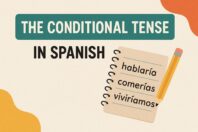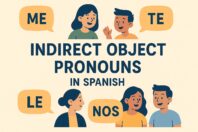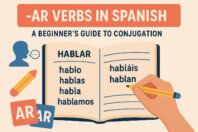Intermediate Spanish: 5 Common Mistakes To Avoid

Get our free email course, Shortcut to Conversational.
Have conversations faster, understand people when they speak fast, and other tested tips to learn faster.
More infoDo you repeat the same old intermediate Spanish mistakes?
Although the term “intermediate Spanish” is a little subjective, we define it as the stage where you can have coherent Spanish conversations on most topics, but still make minor errors – be it grammar related, confusing vocab or other.
Otherwise known as “intermediate hell”, this is the stage where you need to fine-tune your grammar, expand your range of vocab and avoid the minor mistakes that beginners tend to make
If you don’t consider yourself to be intermediate level, then we recommend first reading this post on Spanish beginner mistakes.
And now, we’ll cover the 5 most common mistakes that intermediate Spanish students tend to make.
1) Ya vs. Todavía/Aún (Already vs. Yet/Still)
These Spanish adverbs are used by native speakers on a daily basis, and can tell us if something has ended or is still active.
Since many intermediate Spanish students confuse these adverbs, in this section, we’ll clarify how each one is correctly used.
a. Ya – Already
Ya is generally used to indicate that something has already finished, or is already completed, but can also be used in order to express immediacy relating to a future action or event.
Let’s see some examples of these cases:
Immediacy
- Can we go now? Yes, we can go now – ¿Podemos irnos ya? ¡Si! ya nos podemos ir
- Are you ready? Yes! now I’m ready – ¿Ya estás lista? ¡Si! Ya estoy lista
Actions already finished
- I was cooking, but I already finished – Estaba cocinando, pero ya terminé.
- Juan is already at home. – Juan ya está en casa
Future Actions
- We will see how all that goes – Ya veremos como sale todo
- Next week I’ll be already on my way back home – La próxima semana ya estaré de regreso a casa
Let’s see more examples:
- Did you already study? Yes, I’ve already finished – ¿Ya estudiaste?, Si ya terminé
- Have you read the book recommended by the teacher? Yes, I already read it – ¿Ya leíste el libro que recomendó el profesor? Si, ya lo leí
- I used to smoke a lot. But I don’t smoke anymore – Yo solía fumar mucho. Pero ya no fumo más
- She has already arrived from school – Ella ya llegó del colegio
- They already bathed – Ellos ya se bañaron
In the above examples, ya is placed near the beginning of a sentence, or at the very beginning of it. However, it’s not uncommon to also hear a native speaker use ya at the end of a sentence.
For example:
- Did you already study? Yes, I’ve already finished – ¿Ya estudiaste?, Si, terminé ya
- Have you read the book recommended by the teacher? Yes, I already read it – ¿Ya leíste el libro que recomendó el profesor? Si, lo leí ya
- She has already arrived from school – Ella llegó del colegio ya
- They already bathed – Ellos se bañaron ya
There’s no clear rule about where ya should be placed, and when. If you’re not sure, then simply imitate how you hear it being used by native speakers and you can’t go wrong.
One last thing to mention is that ya can be used as a standalone response -without any other information in the sentence.
For example
- Are you done with the bathroom? – ¿Terminaste de usar el baño?
- Ya (I’ve finished)
- What date is your exam? – ¿Qué día es tu examen)
- Ya (It already happened)
- When will you be ready to go out? – ¿Cuando vas a estar lista para salir?
- Ya (I’m ready)
- Did you finish your breakfast? – ¿Terminaste tu desayuno?
- Ya (I already finished it)
- Did you do the homework? – ¿Hiciste la tarea?
- Ya (I already did it)
b. Todavía or Aún – Yet / Still
We use “todavía” or “aún” to talk about an ongoing situation, that has not been finished yet.
Before diving into more the specific details, it’s worth mentioning that “todavía” and “aún” are interchangeable.
- I’m still studying at the University – Todavía/Aún estoy estudiando en la Universidad
- I’m still sick and I can’t go out – Todavía/Aún estoy enferma y no puedo salir
Todavía and aún are also used to form negative sentences, though the meaning will slightly change.
For example:
- I don’t have a car yet – Todavía/Aún no tengo un carro
In the above sentence, todavía/aún is used to say that right now, I don’t have the car, but later maybe I will.
Let’s see more examples:
- I haven’t bought the shoes yet – Todavía/aún no he comprado los zapatos
- We are still dating – Todavía/Aún estamos saliendo
- My grandmother is still alive – Mi abuela todavía/aún está viva
- I still don’t have the class notes – Todavía/aún no tengo los apuntes de la clase
2) Spanish Preterite v Imperfect Past
You probably expected to see this one on the list.
So how do you stop confusing the Spanish preterite (simple past tense) and the imperfect past tense once and for all?
Allow us to explain.
a. Spanish Preterite (simple past)
The Spanish preterite or simple past tense is used to describe actions that were completed at a specific point in the past and have no relation to the present.
In other words, the action happened once, and was completed.
- I bought my car last year – El año pasado compré mi carro
- I moved to this city 4 years ago – Hace 4 años me mudé a esta ciudad
- I went to a birthday party last Saturday – El sábado pasado fuí a una fiesta de cumpleaños
(read our full explanation on the Spanish preterite here)
b. Past Imperfect
The past imperfect Spanish tense is used to talk about past actions, conditions or events that occurred habitually, or a continuous past action, which may or may not have been completed.
Additionally, it is used when giving describing weather, time, people, age, physical characteristics, feelings or emotions in the past.
Ok, we can admit that was a lot to take in.
Let’s have a look at some examples of the past imperfect tense in action so that you can see how it works.
- I had a friend that was really pretty – Yo tenía una amiga que era muy guapa
- I was really nervous the day of the exam – El día del exámen yo estaba muy nerviosa
- When we were walking through the park it was raining – Ayer llovía cuando estábamos caminando por el parque
(we wrote a full explanation to past imperfect Spanish here)
Now, we can compare Spanish preterite and the imperfect past tense side-by-side so that you can see how both are used.
| Spanish Preterite | Example | Imperfect Spanish | Example |
| Something that happened once in the past (yesterday, last week, last year) | Mis padres se casaron en 1981
— My parents got married in 1981 |
Talk about habits in the past. | Yo jugaba fútbol todas las tardes después del colegio
— I used to play soccer every afternoon after school |
| To talk about things in the past that had a beginning and an end | El sábado fuimos a la playa y regresamos el domingo
— On Saturday we went to the beach and we returned on Sunday |
Descriptions of things from the past (people, situations, age) | A los 15 años yo era muy flaca
— At 15 years old I was very thin |
| To talk about interrupted actions | Yo Estudiaba cuando mi mamá me llamó
— I was studying when my mom calls me |
One final tip to remember. The imperfect past tense can be used as an equivalent to saying that you “used to” to do something in English, or you were doing something. Normally the context will make it clear which of the two you wish to express.
For Example Preterite: Yo bailé (I danced) vs Imperfect: Yo bailaba (I used to dance or I was dancing)
3) Por vs. Para
The confusion surrounding Por vs Para is something that every Spanish student can relate to.
In English, both words translate to “for”, but in Spanish, the words are not interchangeable and are used differently, depending on the context.
In this section, we will clarify how exactly you can differentiate them.
a. Para (in order to, for)
Para is used when talking about something that has a final destination.
For example, if you are giving somebody a present, then the present has a final destination and so we use para. The same logic applies to places and deadlines.
We like to say that para is like a straight line, and is used when something goes from A to B.
Let’s see some examples:
- This cake is for the birthday – Esta torta es para el cumpleaños
- This present is for my grandma – Este regalo es para mi abuela
- This soap is for bathing the dog – Este jabón es para bañar al perro
- This brush is for the teeth – Este cepillo es para los dientes
- In order to understand the lesson, you should study – Para comprender la lección, debes estudiar
- You must have the homework ready for monday – Debes tener la tarea lista para el lunes
We use para in these examples because the object of each sentence has a final destination, or has one purpose and nothing more.
Once again, it’s best to think of para for anything that goes in a straight line, direct to the place, person or thing that corresponds with the action.
b. Por: Because of, by, along, on, during, in, for, per, on behalf of, through
If para is a straight line, por is more like a curved line.
Por is a path to everything that we do, everything that surrounds us and isn’t as specific as para.
Por is also used to talk about time, frequency or duration of an activity or event.
- It’s very cold in the morning – Hace mucho frío por la mañana
- I lived in Mexico for 2 years – Yo viví en México por dos años
- I was waiting for two hours – Estuve esperando por dos horas
When speaking about a location or route, por is used as “by”.
- Today I was walking through the park when I met my friend – Hoy estaba caminando por el parque cuando me encontré a mi amiga
- When I go to work, I go down that street every day – Cuando voy a mi trabajo, paso por esa calle todos los días
- I searched for a vegan restaurant everywhere and did not find any – Busqué un restaurante vegano por todos lados y no encontré ninguno
As you can see, por is used in a non-specific way (the only exception being time).
c. When to use “Por mí” and “Para mí”
The last point is something that, once again, causes a lot of confusion for many students.
The phrase “por mí” at the end of the sentence, as we have shown so far, can be translated as “because of me”.
- You have traveled to Japan because of me – Has viajado a Japón por mí
- I behave like this for you – Me comporto así por ti
When used the beginning of a sentence, it is translated slightly different, and means “as far as I’m concerned”.
- As far as I’m concerned, they can fire him – Por mí, lo pueden despedir
- As far as I’m concerned, they can go now – Por mí, se pueden ir ya
The phrase “para mí” is also translated differently, depending on where it’s placed in a sentence.
When placed at the end of a sentence, it means “for me”:
- The cake is for me – La torta es para mí
- The car is for me – El carro es para mí
When placed at the beginning of a sentence, its meaning changes to in my opinion (as in: from my perspective)
- In my opinion, the Spanish language is one of the most beautiful languages – Para mí, el español es uno de los idiomas más hermosos
- In my opinion, people in latin america are socially more open than most of the asian people – Para mí, las personas en latinoamérica son más abiertas socialmente que la mayoría de los asiáticos
Finally, let’s take a look at two similar sentences and how they change.
- Lo hiciste para mí – You did it for me
- lo hiciste por mí – You did it for me
Sentence 1 means that someone built or made something physical for me.
Sentence 2 means that someone did a particular action or behaved in a certain way because of me. I can not touch it, because it’s an act, not something physical.
4) Confusing Prepositions: Hacia, hasta
“Hacia” and “hasta” are two prepositions both express going to one place, but are not at all interchangeable.
a. Hacia
In English, hacia could be translated as: around, in the direction of, or towards.
This proposition is used to talk about an approach or something imprecise that is not a final destination. It can be used to express movement towards a direction, location or orientation with respect to a specific point.
We also use this proposition to talk about feelings.
Let’s see some examples:
- This road goes to the hospital – Este camino va hacia el hospital
- I feel a lot of love for you – Siento mucho amor hacia ti
- I’m going to school, but I do not know which bus I should take – Voy hacia la escuela, pero no se cual bus debo tomar
- They were going to the beach when they had the accident – Ellos iban hacia la playa cuando tuvieron el accidente
b. Hasta
This proposition can be translated as: unto, to, or until.
Hasta it used to express the endpoint of an action that we are talking about, or indicate the final destination such as place or point (e.g. time) where we are going.
For example:
- I was at the doctor until 3pm – Estuve en el médico hasta las 3pm
- I’m going to my friend’s house – Voy a ir hasta la casa de mi amiga
- His hair reaches to his waist – Su cabello le llega hasta la cintura
- Let’s go to the main square to see if we can get help – Vamos hasta la plaza principal a ver si conseguimos ayuda
5) Avoiding repetition with relative Clauses
Spanish relative clauses are used to join two sentences that have one element in common, helping us avoiding repetition.
For example, in the below sentence, the dog is the one element in common:
- The dog is fat. That dog is funny – El perro es gordo. Ese perro es muy gracioso
If I wanted to say the same thing, but shorter, I would say:
- The dog that is fat is very funny – El perro que es gordo es muy gracioso
More examples:
- The house is in the private beach. I go to the private beach to relax. – La casa está en la playa privada. Voy a la playa privada para relajarme
- La casa que está en la playa privada es donde voy a relajarme.
Below are the different relative clauses that you need to know.
| Relative Clause
English equivalent |
Singular | Plural |
| That | Que | Que |
| The one | El que / La que | Los que / Las que |
| Who | Quién | Quienes |
| Where | Donde | Donde |
- The blue coffee maker is the one my mother uses – La cafetera azul es la que usa mi madre
- This is the school where I studied. – Esta es la escuela donde estudié
- These are the gifts that I told you – Estos son los regalos que te dije
- They are the guests that went to the party. – Ellos son los invitados que fueron a la fiesta
- She is the one who plays piano very well – Ella es la que toca piano muy bien
- This is where the meeting will be – Aquí es donde será la reunión
Exercises
- La cena _____ está lista. (Dinner is ready)
- ______ no nos hemos casado (We have not married yet)
- _____ las entradas al concierto ayer. (I bought tickets to the concert yesterday)
- Yo también _____ ejercicios en ese parque. (I used to exercised in that park)
- Voy a comprar pizza _____ la cena. (I’m going to buy pizza for dinner.)
- Estoy caminando ____ el centro comercial. (I’m walking through the mall)
- Voy a ir _____ la escuela esta tarde. (I’m going to school this afternoon)
- ¡ _____ mañana! (See you tomorrow!)
- Ella es mi amiga _____ vino a visitarme para celebrar mi graduación (She is my friend who came to visit me to celebrate my graduation)
- Este es el gato _____ rescatamos anoche (This is the cat that we rescued last night)
- Aquí es _____ nos quedaremos en las vacaciones. (This is where we will stay on vacation)
Answers
- La cena ya está lista
- Todavía no nos hemos casado
- Compré las entradas al concierto ayer
- Yo también hacía ejercicios en ese parque
- Voy a comprar pizza para la cena
- Estoy caminando por el centro comercial
- Voy a ir hacia la escuela esta tarde
- ¡Hasta mañana!
- Ella es mi amiga quien vino a visitarme para celebrar mi graduación
- Este es el gato que rescatamos anoche
- Aquí es donde nos quedaremos en las vacaciones



